As a field, molecular spectroscopy is as
wide as the Mississippi River and as deep as the Mariana Trench.
Alone or in conjunction with liquid and gas chromatography instruments,
a good spectroscopy system can be used to explore DNA and RNA as well as proteins
of various shapes and sizes. It can be used to measure the growth of bacterial cultures
and to analyze enzyme kinetics. The right technique will let you nail down the conformation of a protein; the wrong one will leave you baffled as to why your data results aren’t what you expected.
In molecular analysis, absorption, emission and reflection spectroscopic
techniques are all fair game. Using wavelengths from the ultraviolet to the visible
to the infrared is common, as is exploiting Raman signals. Other methods include
x-ray and nuclear magnetic resonance spectroscopy, although these are not, strictly
speaking, photonic. The right choice of equipment and technique can reveal information
on the morphology, vibration, rotation and energy state of any target molecule –
though, in many cases, you should already have some idea of what molecule you are
examining.
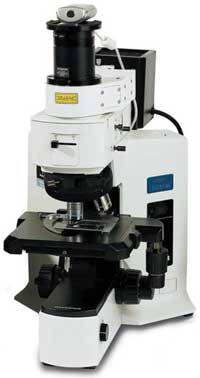
Courtesy of Perkin Elmer.
With all these options, how do you even know where to begin to
choose the right instrument for a particular task?
According to one researcher at Imperial College London, some spectroscopists
purchase the “best” instrument they can afford, regardless of their
actual needs. Their hope is that the equipment will also serve future – and
unknown – needs. Such overbuying leads to owning equipment that is performing
tasks that could be done by less sophisticated units. Still, the researcher said,
this kind of “future proofing” is important in erratic funding systems
and could be very appropriate for facilities that can share equipment between labs.
The scientist looking to explore new equipment starts off knowing
what his or her application is but may not know where to go from there. Strikingly,
they might not know which wavelength range or technique to consider. That’s
where a vendor’s technical salesperson or product associate might come in.
“There is a tremendous learning curve as to the differences
and appropriate uses of each technology,” said D. Michael Olive of Li-Cor
Biosciences in Lincoln, Neb., which specializes in imaging and chemical detection
instrumentation. “We spend considerable effort on customer education.”
Should you find yourself exploring the biota of the oceans –
perhaps investigating the contents of the Mariana Trench’s deeply buried sediments
or the qualities of its hydrothermal plumes – be sure to bring the right equipment.
Aside from the appropriate modality, there are several criteria
you should consider when selecting a spectroscopy system: the budget, your own expertise
and experience with a technique, the field of view required for the sample, the
light sources available, detector sensitivity and functionality, and data analysis
software. Also factored into the mix are reliability, the quality of customer service
provided by the vendor, warranties and overall cost of ownership, and ease of use.
Instruments that seek absorbance or reflectance data in these wavelengths can cover wide or narrow ranges of spectra. Any range can be used to identify particular molecules
within samples, such as the biological macromolecules common to pharmaceuticals.
UV/VIS spectrophotometers also are used as an adjunct to high-performance liquid
chromatography. Courtesy of Horiba Scientific.
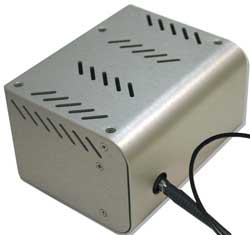
Type: UV-VIS-NIR
Representative Manufacturers: Avantes; B&W Tek; BaySpec; Foss
NIR-Systems; Hamamatsu; Horiba Scientific (Model VS7000, pictured); McPherson; Ocean
Optics; PerkinElmer; Princeton Instruments; StellarNet; tec5; Varian (now part of
Agilent Technologies)
Dealing with readings of inelastic scatterings
of UV, visible or near-IR light, Raman spectroscopy is often associated with the
study of proteins and DNA, with forensic analysis, and with identification of unique
substances within compounds and of functional groups within individual molecules. Courtesy of B&W Tek Inc.
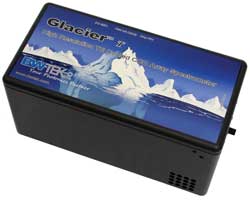
Type: Raman
Representative Manufacturers: Agilent Technologies; Andor Technology;
B&W Tek (Glacier T, pictured); BaySpec; Bruker Optics; Jasco; Lambda Solutions;
Ocean Optics; Princeton Instruments
Fluorescence spectroscopy is used mainly to analyze molecular interactions
and to study the structures and functions of biomolecules. It is also used to identify
biocompounds such as toxins in forensic and security applications. Wavelengths used
in this technique typically are the near-IR and visible but can drift toward the
UV for identifying some classes of materials. Courtesy of Jasco Inc.
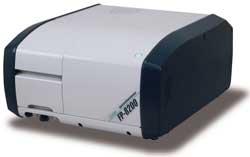
Type: Fluorescence
Representative Manufacturers: B&W Tek; Horiba Scientific;
Jasco (Model FP-8200, pictured); Ocean Optics
Fourier transform infrared (FTIR) spectroscopy is used to gain structural
information about both organic and inorganic molecules, especially when it is necessary
to use nondestructive analysis. It is used in applications ranging from characterizing
the oil content of seeds to determining how well a lotion is absorbed by the skin. Courtesy of Interspectrum.
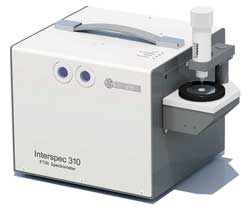 Type: FTIR
Type: FTIR
Representative Manufacturers: Bristol Instruments; Bruker Optics;
Interspectrum (Interspec 310, pictured); Jasco; PerkinElmer; Shimadzu Scientific
Instruments; Thermo Fisher Scientific
Adding an imaging component to a spectroscopy system is useful for mapping out the distribution of materials within a larger sample, such as the active ingredients within a pill. Spectra are collected at each pixel on a CCD or CMOS chip, providing thousands of
data points for each reading. It is used, for example, to study nutrient uptake
in samples as small as leaves and as large as coral reefs. Courtesy
of McPherson Inc.
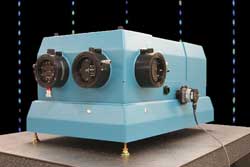
Type: Imaging
Representative Manufacturers: Horiba Scientific; McPherson (Model
2061, pictured); Ocean Optics; Photon etc.; Princeton Instruments
Info Scan
For more information on spectroscopy equipment and applications, see these recent articles on photonics.com:
“Selecting CCDs for Raman Spectroscopy” – John
Gilmore, Hamamatsu Corp., www.photonics.com/WA45915.
“Optimizing an EMCCD for Spectroscopy” – Mayank
Tripathi, Andor Technology, www.photonics.com/WA31367.
“The Best of Both Worlds for Spectroscopy” –
Antoinette O’Grady, Princeton Instruments, www.photonics.com/WA25655.
Data Diving
All optical spectrometry techniques rely on the measurement of radiant
power. The configuration of the instrument varies based on the measurement technique:
absorption, emission, luminescence or scattering. But all of those used in the UV,
visible and IR employ essentially the same subcomponents, including sources and
detectors of radiant power, light discriminators, optical coupling and steering
devices, signal processing electronics, and data analysis and presentation software.
The exact combination, their spectral range of operation and the acceptance of performance
requirements are very application-specific but often include resolution, sensitivity,
detection linearity, speed of acquisition and, of course, cost.
“Spectroscopy: The Tools of the Trade,” John R. Gilchrist,
Gilden Photonics Ltd., The Photonics Handbook
For more information on selecting the right laser or other light
source, discriminators, optical detectors, steering and coupling optics, signal
processors and analytical software, see Gilchrist’s article at www.photonics.com/WA25118.